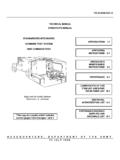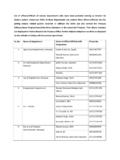Transcription of Data Quality in Clinical Research - Columbia University
1 Chapter 10. data Quality in Clinical Research Meredith Nahm Abstract Every scientist knows that Research results are only as good as the data upon which the conclusions were formed. However, most scientists receive no training in methods for achieving, assessing, or controlling the Quality of Research data . topics central to Clinical Research informatics. This chapter covers the basics of collect and process Research data given the available data sources, systems, and people. data Quality dimensions specific to the Clinical Research context are used, and a framework for data Quality practice and planning is developed. Available Research is summarized, providing estimates of data Quality capability for common Clinical Research data collection and processing methods. This chapter provides researchers, informaticists, and Clinical Research data managers basic tools to plan, achieve, and control the Quality of Research data . Keywords Clinical Research data data Quality Research data collection.
2 Processing methods Informatics Management of Clinical data data accuracy Clinical Research data Processes and Relationship to data Quality data Quality is foundational to our ability to human Research . data Quality is so impor- tant that an Institute of Medicine report [1] was written on the topic. Further, two key thought leaders in the Quality arena, W. E. Deming and A. Donabedian, specifically addressed data Quality [2 4]. Failing to plan for data Quality is an implicit assumption that errors will not occur. Emphasizing that failing to plan for data Quality further threatens data Quality by inhibiting the detection of errors when they do occur, Stephan Arndt et al. state, M. Nahm, Informatics, Duke Translational Medicine Institute, Duke University , 2424 Erwin Road, Durham, NC 27705, USA. e-mail: Richesson, Andrews (eds.), Clinical Research Informatics, Health Informatics, 175. DOI , Springer-Verlag London Limited 2012. 176 M. Nahm Ironically, there is a major difference between a process that is presumed through inaction to be error-free and one that monitors mistakes.
3 The so-called error-free process will often fail to note mistakes when they occur [5]. Quality is broadly defined by Juran as fitness for use [6]. Unfortunately, for clini- cal investigators and Research teams, the use varies from study to study. In Clinical Research , data collection processes are often customized according to the scientific questions and available resources, resulting in different processes for individual studies or programs of Research . Because data Quality assurance and control are largely dependent on how data are collected and processed, they are complicated by this mass customization. (The label mass customization used to describe Clinical Research by Karen Koh in a meeting at Duke Clinical Research Institute.) Given the likely persistence of science-driven customization, an antidote may lie in methods for data Quality planning. It is only when a planning framework exists and is used that knowledge gained from work on prior projects can translate to new projects with different data sources, processes, and people.
4 The types of data collected in Clinical Research include data that are: manually abstracted or electronically extracted from medical records, observed in Clinical exams, obtained from laboratory and diagnostic tests, or from various biological monitoring devices, and patient-reported items. Each data source is associated with a method by which the data were acquired. After acquisition, these data are subject to further processing. Whether data are collected specifically for a Research project, or whether data collected for other purposes are used, a data Quality plan should take into account the data source, precollection processing, the data acqui- sition method, and, finally, postprocessing. While these elements of the data qual- ity plan apply regardless of where the data were collected, the data sources will likely influence the plan. In other words, one method does not fit all. Using the same method to treat all data will overlook both errors and opportunities to prevent them. For example, data recorded on a form may be retrospectively abstracted from medical records, may be written directly onto the form by the patient, or may be recorded directly on the form by a provider during a study visit.
5 Each of these data acquisition processes is subject to different sources of error and, therefore, may benefit from different error prevention or correction methods, thus the need to take into account the data source, precollection processing, data acquisition, and postprocessing in data Quality planning. This chapter is primarily concerned with how to accomplish this and will give the reader a framework to use to assure and control Quality regardless of the data source, acquisition method, or processing. Similar to the decreased property value of a house with a serious foundation problem, it is no surprise that Research conclusions are only as good as the data upon which they were based. As plans and construction of a house help determine Quality , well-laid Research protocols must address data Quality considerations, for example, by specifying a consistent suitable collection method, planning interrater reliability assessments for subjective assessments, or other collection of indepen- dent data .
6 The resulting degree of data Quality affects how data can be used and, ultimately, the level of confidence that can be reposed in Research findings or other 10 data Quality in Clinical Research 177. Definition, collection, processing, and representaion impact data and information Quality data Definiton data data and information Collection Quality impact use data Processing data data data Quality Representaion Use data and information use impacts Quality Fig. Impacts of data generation and handling features on data and information Quality . The way data and information are handled impacts the Quality of that data and information. The Quality of data and information impacts our willingness and ability to use it. Use of data and information causes more care to be taken in their handling, increasing the Quality decisions based on the data . Thus, protocol and Case Report Form (CRF) design, including data capture methods, must be concerned with data Quality assurance measures from the start.
7 data Quality and the discipline of informatics are inextricably linked. data defini- tion, collection, processing, representation, and use are central to informatics (Fig. ). Definition, collection, processing, representation, and use impact data and information Quality , and data and information Quality impact use. In turn, data and information that are used are more likely to have higher Quality . In Clinical Research , data can be collected both prospectively and retrospectively, depending on the proto- col and local procedures at the Clinical investigational site. Therefore, information use in Clinical care as well as information use in the study may impact data Quality . Each step in the collection, handling, and processing of data affects data Quality . International Conference on Harmonization (ICH) guidelines state, Quality con- trol should be applied to each stage of data handling to ensure that all data are reli- able and have been processed correctly [7]. We suggest a less literal interpretation of the ICH E6 guidance document.
8 The gold standard in achieving Quality is preven- tion rather than after-the-fact finding and fixing errors; thus, interventions aimed at preventing errors are typically designed into data collection and handling processes, , part of the process rather than an after-the-fact checking activity applied to a data handling step. Similarly, methods for monitoring data Quality are built into data collection and handling processes. 178 M. Nahm Assuring and controlling data Quality are largely a focus on the presence of data errors, defined here as a data value that does not accurately reflect the true state of the thing being represented. data represent things (or states of things) in the real world. Since all things change with time, so does the accuracy with which a data value rep- resents the true state of the represented thing. Thus, data that are correct will not necessarily remain so with the passage of time. The qualifiers necessary for a given datum to remain accurate over time are often referred to as context, for example, patient age as of the first study visit; or air temperature in degrees Celsius at latitude N, longitude W, at an elevation of 2,310 ft at noon on May 23, 2009; or medications taken within the 10-day time window before the blood draw (see discussions of reliability and validity in Chaps.)
9 4 and 11). The use of a broader definition than inaccuracies created in data processing, or nonconformance to data specifications, is intentional because inaccuracies from any source may render data values incorrect. data Quality can be compromised at any point along the con- tinuum of data collection and processing, as demonstrated by the following examples adapted from actual cases. In this chapter, we develop and apply a framework for preventing and controlling data errors in the context of Clinical Research . The following examples come from the Society for Clinical data Management [8]. Example 1. A large multisite Clinical trial was sponsored by a pharmaceutical company to obtain marketing authorization for a drug. During the final review of tables and listings, an oddity in the electrocardiogram (ECG) data was noticed. The mean heart rate, QT interval, and other ECG parameters for one Research site differed significantly from those from any other site; in fact, the values were similar to ones that might be expected from rather than human subjects.
10 The data listed on the data collection form were checked and were found to match the data in the database, thereby ruling out data entry error; moreover, there were no outliers from that site that would have skewed the data . After further investigation, it was discovered that a single ECG machine at the site was the likely source of the discrepant values. Unfortunately, the site had been closed, and the investigator could not be contacted. Example 2. In the course of a Clinical Research study, data were single entered at a local data center into a Clinical data management system. During the analysis, the principle investigator noticed results for two questions that seemed unlikely. The data were reviewed against the original data collection forms, and it was discovered that on roughly half of the forms, the operator entering the data had transposed yes and no. Closer examination failed to identify any charac- teristics particular to the form design or layout that might have predisposed the operator to make such a mistake; rather, the problem was due to simple human error, possibly from working on multiple studies with differing form formats.






